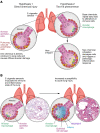What are the mechanisms underlying vaping-induced lung injury?
- PMID: 32391805
- PMCID: PMC7260008
- DOI: 10.1172/JCI138644
What are the mechanisms underlying vaping-induced lung injury?
Conflict of interest statement
Figures

Similar articles
-
Lipid-Laden alveolar macrophages and vaping: Lessons from EVALI.EBioMedicine. 2020 Oct;60:103010. doi: 10.1016/j.ebiom.2020.103010. Epub 2020 Sep 21. EBioMedicine. 2020. PMID: 32971470 Free PMC article. No abstract available.
-
An Emerging Crisis: Vaping-Associated Pulmonary Injury.Ann Intern Med. 2020 Jan 7;172(1):57-58. doi: 10.7326/M19-2908. Epub 2019 Oct 8. Ann Intern Med. 2020. PMID: 31590182 No abstract available.
-
Lipid-laden macrophages as biomarkers of vaping-associated lung injury.Lancet Respir Med. 2020 Feb;8(2):e6. doi: 10.1016/S2213-2600(19)30476-X. Lancet Respir Med. 2020. PMID: 32035068 Free PMC article. No abstract available.
-
Imaging Findings of Vaping-Associated Lung Injury.AJR Am J Roentgenol. 2020 Mar;214(3):498-505. doi: 10.2214/AJR.19.22251. Epub 2019 Oct 8. AJR Am J Roentgenol. 2020. PMID: 31593518 Review.
-
Electronic cigarettes: Modern instruments for toxic lung delivery and posing risk for the development of chronic disease.Int J Biochem Cell Biol. 2021 Aug;137:106039. doi: 10.1016/j.biocel.2021.106039. Epub 2021 Jul 6. Int J Biochem Cell Biol. 2021. PMID: 34242684 Review.
Cited by
-
A Retrospective Analysis of Chemical Constituents in Regulated and Unregulated E-Cigarette Liquids.Front Chem. 2021 Oct 28;9:752342. doi: 10.3389/fchem.2021.752342. eCollection 2021. Front Chem. 2021. PMID: 34778207 Free PMC article.
-
The implications of vaping for the anaesthetist.BJA Educ. 2021 Jul;21(7):243-249. doi: 10.1016/j.bjae.2021.02.001. Epub 2021 Mar 18. BJA Educ. 2021. PMID: 34178380 Free PMC article. Review. No abstract available.
-
Carrier Solvents of Electronic Nicotine Delivery Systems Alter Pulmonary Surfactant.Chem Res Toxicol. 2021 Jun 21;34(6):1572-1577. doi: 10.1021/acs.chemrestox.0c00528. Epub 2021 May 4. Chem Res Toxicol. 2021. PMID: 33945261 Free PMC article.
-
Vaping-related lung injury.Virchows Arch. 2021 Jan;478(1):81-88. doi: 10.1007/s00428-020-02943-0. Epub 2020 Oct 27. Virchows Arch. 2021. PMID: 33106908 Free PMC article. Review.
-
The history, evolution, and practice of cannabis and E-cigarette industries highlight necessary public health and public safety considerations.J Safety Res. 2023 Feb;84:192-203. doi: 10.1016/j.jsr.2022.10.019. Epub 2022 Nov 11. J Safety Res. 2023. PMID: 36868647 Free PMC article. No abstract available.
References
-
- Chadi N, Schroeder R, Jensen JW, Levy S. Association between electronic cigarette use and marijuana use among adolescents and young adults: a systematic review and meta-analysis [published online August 12, 2019]. JAMA Pediatr. https://doi.org/10.1001/jamapediatrics.2019.2574. - PMC - PubMed
-
- Berlin I, Thomas D, Le Faou AL, Cornuz J. COVID-19 and smoking [published online April 3, 2020]. Nicotine Tob Res. https://doi.org/10.1093/ntr/ntaa059. - PMC - PubMed

